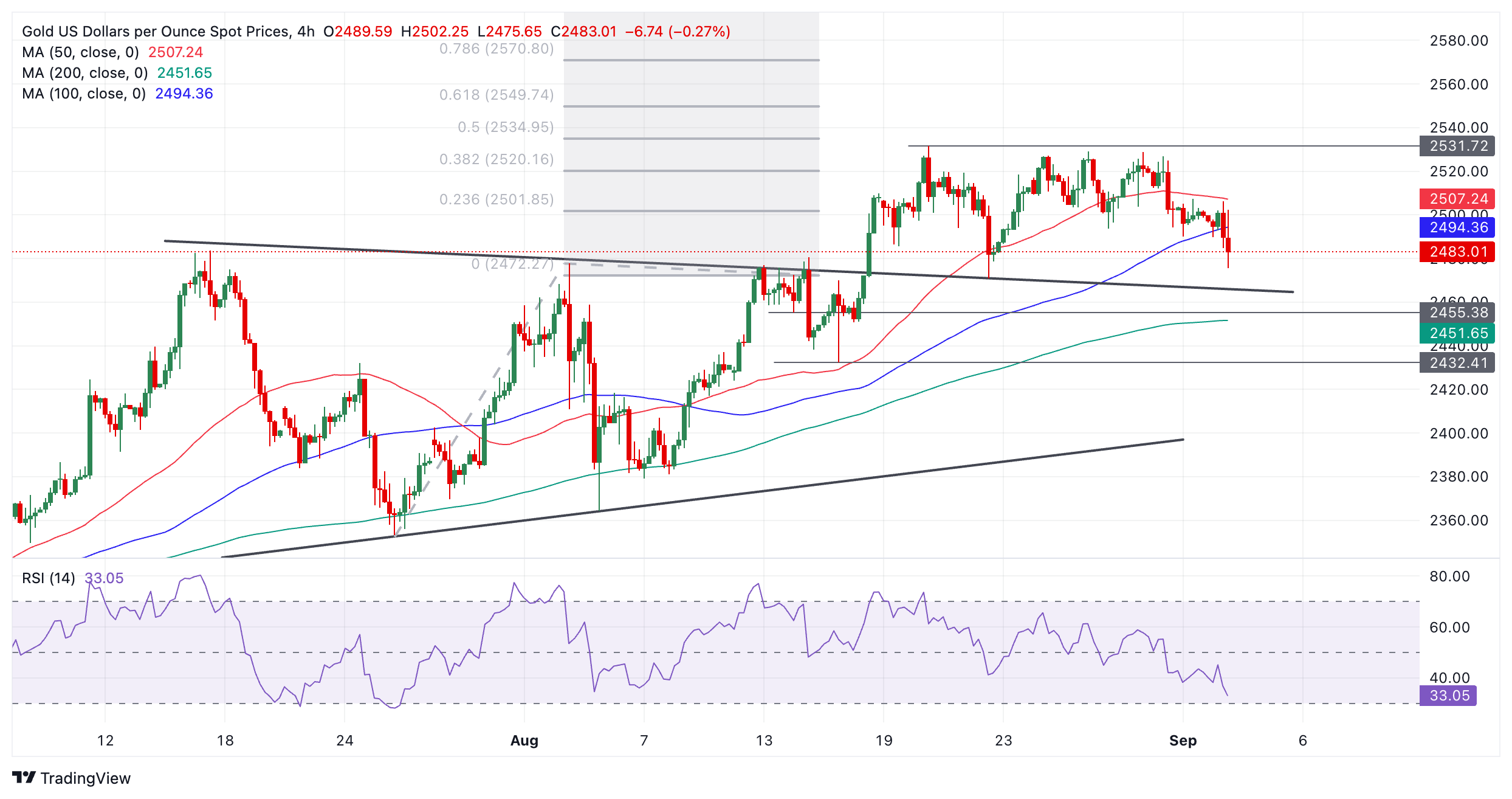Gold drops to fresh lows amid market-wide sell-off

- Gold trades breaks below $2,500 amid a financial-market wide sell-off.
- Traders await US labor market data this week which will help determine future course of interest rates.
- The break below $2,500 is key from a technical perspective as it threatens a bearish reversal.
Gold (XAU/USD) trades in the $2,480s on Tuesday on the back of a broad financial market sell-off that sees most commodities and indexes trading lower. US stock indexes are down over 1.0%, WTI Oil is down 4.0% and Gold itself is nursing losses of 0.50% during the US session.
Just-released US ISM Manufacturing PMI data showed a slowdown in Manufacturing activity in August to 47.9 from 48.0 in July when no-change had been expected. The Employment Index, however, rose to 46.0 from 43.4 in the previous month, allaying fears regarding the reslience of the US labor market.
The US Dollar (USD) – to which Gold is negatively correlated – has slowed in its recovery rally, trading marginally lower on Tuesday as traders keep their powder dry ahead of the release of potentially market-moving US labor market data this week.
Investors are awaiting the final “test results” for the patient – in this case the US economy – before drawing any conclusions about the likely course of action ahead, in terms of the Federal Reserve’s (Fed) decision on how much to cut interest rates – a key driver of Gold.
Demonstrations in Tel Aviv, demanding a ceasefire in Gaza after seven Israeli hostages were found dead, and the calling of a general strike by Israeli workers have, if anything temporarily, dialed down the threat level in at least one key geopolitical hotspot, adding to the uneasy calm permeating markets.
Gold traders look ahead to US employment data
Gold price is most likely to see volatility from the release of US labor market data this week. At his pivotal speech in Jackson Hole, Fed Chairman Jerome Powell turned the spotlight away from inflation and onto the fragile-looking labor market, suggesting that downside risks to employment were now greater than upside risks to inflation.
If labor market data out this week in the form of the ISM Manufacturing Employment Index on Tuesday, JOLTS Job Openings on Wednesday, ADP Employment Change, Jobless Claims and ISM Services Employment Index on Thursday, and Nonfarm Payrolls (NFP) on Friday, come out weaker than expected and back up his concerns, it will probably lead to a tumble in the US Dollar (USD) but a rise in the price of Gold.
Markets are debating whether the Fed will need to make a 50 basis point (bps) cut to interest rates in September or just a standard 25 bps cut. The latter is fully expected whilst market-based probabilities for the former sit currently at around 30%, according to the CME FedWatch Tool.
If labor market data is decidedly under par, the chances of a bigger cut will increase, which in turn will give Gold a leg up on the charts. Lower interest rates are positive for the precious metal because they make it comparably more attractive to investors as a non-interest-paying asset.
Technical Analysis: Breaks below base of mini-range
Gold (XAU/USD) is breaking below the base of the mini-range it has been trading in since late August, between $2,500 and $2,531. It has eroded the range floor, making lower lows as it descends. It seems it has now entered a new zone of activity between the sloping top of the old range highs at about $2,470 and the former range floor at $2,500.
XAU/USD 4-hour Chart
Despite the weakness, an un-met upside target for Gold sits at $2,550 and remains active. This was generated after the original breakout from the prior range that started in July, which also looks like a triangle pattern because of its sloping edges.
This upside target was calculated by taking the 0.618 Fibonacci ratio of the range or triangle’s height and extrapolating it higher. This target is the minimum expectation for the follow-through from a breakout based on principles of technical analysis.
Gold’s medium and long-term trends remain bullish, which, given “the trend is your friend,” means the odds favor an eventual breakout higher materializing.
Yet it would require a break above the August 20 all-time high of $2,531 to provide more confirmation of a continuation higher toward the $2,550 target.
Alternatively, a break back inside the previous range would negate the projected upside target. Such a move would be confirmed on a daily close below $2,470 (August 22 low). It would change the picture for Gold and suggest that the commodity might start a short-term downtrend.
Economic Indicator
ISM Manufacturing PMI
The Institute for Supply Management (ISM) Manufacturing Purchasing Managers Index (PMI), released on a monthly basis, is a leading indicator gauging business activity in the US manufacturing sector. The indicator is obtained from a survey of manufacturing supply executives based on information they have collected within their respective organizations. Survey responses reflect the change, if any, in the current month compared to the previous month. A reading above 50 indicates that the manufacturing economy is generally expanding, a bullish sign for the US Dollar (USD). A reading below 50 signals that factory activity is generally declining, which is seen as bearish for USD.
